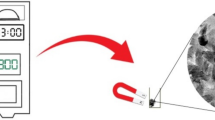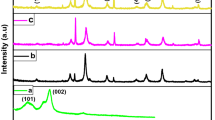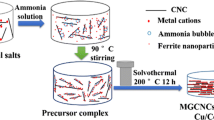Abstract
Due to unique nanoscale properties, as superparamagnetism, iron oxide nanoparticles (IONPs) hybridized with cellulosic matrixes are an attractive material for environmental purposes. Previous studies obtained IONPs–cellulose clusters by the coprecipitation route. Nevertheless, the forces which bind IONPs and cellulosic matrixes and allow the nanocluster formation have not been well described. This study investigated the nanoclustering formation of superparamagnetic (SPM) IONPs and cellulosic materials. IONPs nanoclusters and hybrids were coprecipitated with microcrystalline cellulose (MC) in mass proportions of 1:0.5, 1:2, and 1:8. Lignocellulosic residues (LR) were also used as an organic matrix in mass proportions of 1:2. Dynamic light scattering analyses revealed that the obtained IONPs-organic clusters present sizes between 1.46 ± 0.49 and 6.84 ± 3.15 µm. The MC and LR organic matrix size were decisive for the hybrids’ final cluster size. Scanning electron microscopy images of the materials show an irregular morphology due to particle aggregation, while hybrids showed fibril character and the presence of crystal IONPs deposition at their surfaces. Micro-Raman spectra showed assignments of hematite (α-Fe2O3), goethite (α-FeOOH), magnetite (Fe3O4), and wustite (FeO), as a result of the coprecipitation process. Magnetization assays showed that the obtained clustered hybrids present SPM behavior at room temperature, despite to the cellulosic backbone presence and size. X-ray photoelectron spectroscopy brings light over the nanoclusters surface binding energies, evidencing the hydrogen bonding of the IONPs over the hydroxyl groups of MC and LR, clarifying the nanoclustering formation among heterogeneous IONPs and cellulosic matrixes.
Graphical abstract









Similar content being viewed by others
References
Chaabane L et al (2020) Functionalization of developed bacterial cellulose with magnetite nanoparticles for nanobiotechnology and nanomedicine applications. Carbohydr Polym 247:116707–116719. https://doi.org/10.1016/j.carbpol.2020.116707
Damodaran P (2020) Mesoporous magnetite nanoclusters as efficient nanocarriers for paclitaxel delivery. Chem Sel 5(29):9261–9268. https://doi.org/10.1002/slct.202001102
Ganesan V, Louis C, Damodaran SP (2018) Novel nanoflu-ids based on magnetite nanoclusters and investigation on their clus-ter size-dependent thermal conductivity. T J Phys Chem C 122(12):6918–6929. https://doi.org/10.1021/acs.jpcc.7b12043
Seabra AB, Pelegrino MT, Haddad PS (2017) Antimicro-bial applications of Superparamagnetic iron oxide nanoparticles: perspectives and challenges. Nanostruct Antimicrob Ther. https://doi.org/10.1016/B978-0-323-46152-8.00024-X
Arantes ACC et al (2017) Renewable hybrid nanocatalyst from magnetite and cellulose for treatment of textile effluents. Car-bohydr Polym 163:101–107. https://doi.org/10.1016/j.carbpol.2017.01.007
Zharei S, Niad M, Raanaei H (2018) The removal of mercu-ry ion pollution by using Fe3O4-nanocellulose: synthesis, charac-terizations and DFT studies. J Hazard Mater 344:258–273. https://doi.org/10.1016/j.jhazmat.2017.10.009
Kaco H et al (2017) Preparation and characterization of Fe3O4/regenerated cellulose membrane. Sains Malays 46(4):623–628. https://doi.org/10.17576/jsm-2017-4604-15
Ganesan V et al (2019) Size-controlled synthesis of superparamagnetic magnetite nanoclusters for heat generation in an alternating magnetic field. J Mol Liquids 281:315–323. https://doi.org/10.1016/j.molliq.2019.02.095
Manh-Huong P et al (2016) Exchange bias effects in iron oxide-based nanoparticle systems. Nanomaterials 6(11):221–251. https://doi.org/10.3390/nano6110221
Mohamed MA et al (2017) An overview on cellulose-based material in tailoring bio-hybrid nanostructured photocatalysts for water treatment and renewable energy applications. Int J biol macromol 103:1232–1256. https://doi.org/10.1016/j.ijbiomac.2017.05.181
Gharibshahi R et al (2020) Hybridization of superparamag-netic Fe3O4 nanoparticles with MWCNTs and effect of surface modification on electromagnetic heating process efficiency: a microfluidics enhanced oil recovery study. Fuel 282:118603–118617. https://doi.org/10.1016/j.fuel.2020.118603
Benjwal P et al (2015) Enhanced photocatalytic degradation of methylene blue and adsorption of arsenic (iii) by reduced gra-phene oxide (rGO)–metal oxide (TiO 2/Fe 3 O 4) based nanocom-posites. Rsc Adv 5(89):73249–73260. https://doi.org/10.1039/C5RA13689J
Lian Z et al (2020) EDTA-functionalized magnetic chitosan oligosaccharide and carboxymethyl cellulose nanocomposite: syn-thesis, characterization, and Pb (II) adsorption performance. Inter J Biol Macromol 165:591–600. https://doi.org/10.1016/j.ijbiomac.2020.09.156
Abouzeid RE et al (2018) Current state and new trends in the use of cellulose nanomaterials for wastewater treatment. Biom-acromol 20(2):573–597. https://doi.org/10.1021/acs.biomac.8b00839
Dheyab MA et al (2020) Simple rapid stabilization method through citric acid modification for magnetite nanoparticles. Sci Rep 10(1):1–8. https://doi.org/10.1038/s41598-020-67869-8
Souza AG et al (2019) A new approach for conversion of eucalyptus lignocellulosic biomass into cellulose nanostructures: a method that can be applied in industry. J Nat Fibers. https://doi.org/10.1080/15440478.2019.1691125
Ferreira RR et al (2019) Use of ball mill to prepare nanocellulose from eucalyptus biomass: challenges and process optimization by combined method. Mater Today Commun 22:100755–100768. https://doi.org/10.1016/j.mtcomm.2019.100755
de Souza AG et al (2019) Valorization of industrial paper waste by isolating cellulose nanostructures with different pretreat-ment methods., Resour. Conserv Recycl 143:133–142. https://doi.org/10.1016/j.resconrec.2018.12.031
Moosavinejad SM et al (2019) Evaluation of degradation in chemical compounds of wood in historical buildings using FT-IR and FT-Raman vibrational spectroscopy. Maderas Cienc Tecnol 21(3):381–392. https://doi.org/10.4067/S0718-221X2019005000310
Kong D, Wilson LD (2017) Synthesis and characterization of cellulose-goethite composites and their adsorption properties with roxarsone. Carbohydr Polym 169:282–294. https://doi.org/10.1016/j.carbpol.2017.04.019
Makarem M et al (2019) Probing cellulose structures with vibrational spectroscopy. Cellul 26(1):35–79
Sergeeva AV et al (2020) Infrared and Raman spectroscopy of ammoniovoltaite, (NH4)2Fe2+5Fe3+3Al(SO4)12(H2O)18. Miner 10(9):781–795. https://doi.org/10.3390/min10090781
Chai MN, Isa MIN (2013) The oleic acid composition effect on the carboxymethyl cellulose based biopolymer electrolyte, J Cryst Process Tech 3(1) 1–4. http://www.scirp.org/journal/PaperInformation.aspx?PaperID=27263
Testa-Anta M et al (2019) Raman spectroscopy to unravel the magnetic properties of iron oxide nanocrystals for bio-related applications. Nanoscale Adv 1(6):2086–2103. https://doi.org/10.1039/C9NA00064J
Williams GVM et al (2018) Spin-dependent tunnelling in magnetite nanoparticles. J Magn Magn Mater 460:229–233. https://doi.org/10.1016/j.jmmm.2018.04.017
Kumar CSSR (2012) Raman spectroscopy for nano-materials characterization. Springer Sci Bus Media. https://doi.org/10.1007/978-3-642-20620-7
Salviano LB et al (2018) Microstructural assessment of magnetite nanoparticles (Fe3O4) obtained by chemical precipitation under different synthesis conditions. Mater Res 21(2):764–771. https://doi.org/10.1590/1980-5373-mr-2017-0764
Wroblewski C et al (2020) High yield synthesis and application of magnetite nanoparticles (Fe3O4). Magnetochem 6(2):22–34. https://doi.org/10.3390/magnetochemistry6020022
Agarwal UP, McSweeny JD, Ralph SA (2011) FT–Raman investigation of milled-wood lignins: softwood, hardwood, and chemically modified black spruce lignins. J Wood Chem Tech 31(4):324–344. https://doi.org/10.1080/02773813.2011.562338
Kong D, Wilson LD (2018) Structural study of cellulose-iron oxide composite materials. J Mater Sci Chem Eng 6(4):65–77. https://doi.org/10.4236/msce.2018.64009
Furlan DM et al (2019) Sisal cellulose and magnetite nano-particles: formation and properties of magnetic hybrid films. J Mater Res Tech 8(2):2170–2179. https://doi.org/10.1016/j.jmrt.2019.02.005
Francisquini, E., Schoenmaker, J., Souza, J.A., (2014) Nano-partículas magnéticas e suas aplicações. Qum. Supramol, Nano-tecnol,, Atheneu 269
Maccarini M et al (2014) Interactions at the CMC/magnetite interface: implications for the stability of aqueous dispersions and the magnetic properties of magnetite nanoparticles. Colloids Surf A: Physicochem Eng Asp 462:107–114. https://doi.org/10.1016/j.colsurfa.2014.08.026
Guo J et al (2017) Complexes of magnetic nanoparticles with cellulose nanocrystals as regenerable, highly efficient, and selective platform for protein separation. Biomacromol 18(3):898–905. https://doi.org/10.1021/acs.biomac.6b01778
Carvalho-Jr WM et al (2019) Annealing control of hydro-thermally grown hematite nanorods: implication of structural chang-es and Cl concentration on weak ferromagnetism. J Alloys Compd 799:83–88. https://doi.org/10.1016/j.jallcom.2019.05.335
Chauhan I et al (2019) Immobilization of α-Fe 2 O 3 nano-particles on the cellulose surface: role of cellulose in tuning the microstructure and crystallographic phase. Cellul 26(3):1757–1767. https://doi.org/10.1007/s10570-018-2186-4
Dzade NY, Roldan A, Leeuw NH (2014) A density functional theory study of the adsorption of benzene on hematite (α-Fe2O3) surfaces. Miner 4(1):89–115. https://doi.org/10.3390/min4010089
Acknowledgements
The authors would like to thank FAPESP (Fundação de Amparo à Pesquisa do Estado de São Paulo) project number 2018/11277-7; CNPq (Conselho Nacional de Desenvolvimento Científico e Tecnológico), Project number 305819/2017-8 and CAPES (Coordenação de Aperfeiçoamento de Pessoal de Nível Superior) for the support with scholarship.
Author information
Authors and Affiliations
Contributions
The manuscript was written through the contributions of all authors.
Corresponding author
Ethics declarations
Conflict of interest
The authors declare that they have no known competing financial interests or personal relationships that could have appeared to influence the work reported in this paper.
Human or animal rights
This study does not contain any studies with human participants or animals performed by any of the authors.
Informed consent
For this type of study, formal consent is not required.
Associated content
Energy-dispersive X-ray spectroscopy (EDX) and Micro-Raman assignments of the samples, as well as Pearson correlation between the C–C binding energies of the hybrids, are included in this work as Supplementary Material.
Additional information
Handling Editor: Dale Huber.
Publisher's Note
Springer Nature remains neutral with regard to jurisdictional claims in published maps and institutional affiliations.
Supplementary Information
Below is the link to the electronic supplementary material.
Rights and permissions
About this article
Cite this article
Zanata, L., Tofanello, A., Martinho, H.S. et al. Iron oxide nanoparticles–cellulose: a comprehensive insight on nanoclusters formation. J Mater Sci 57, 324–335 (2022). https://doi.org/10.1007/s10853-021-06564-z
Received:
Accepted:
Published:
Issue Date:
DOI: https://doi.org/10.1007/s10853-021-06564-z




